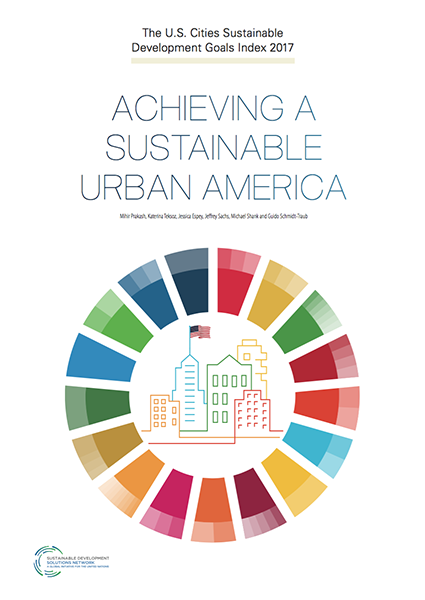More details
Forward
America is a paradox: the world’s leader in technology and dynamism and yet increasingly a laggard in wellbeing, public health, inequality, and even confidence in the future. As is famously known, the U.S. is getting richer but not happier. The paradox is resolved of course by recognizing that money is not everything. A society’s wellbeing depends on its social cohesion, trust in institutions, sense of fairness, good health, and care for the natural environment. In short, wellbeing depends on a holistic vision of sustainable development, embracing the economic, social, and environmental dimensions of wellbeing.
That is why the world’s governments unanimously adopted the Sustainable Development Goals (SDGs) in September 2015, to be reached by 2030. These ambitious goals aim to end poverty and malnutrition, ensure health and education for all, promote gender equality and a fairer distribution of income, and to protect the environment, notably by ending global warming and conserving ecosystems and biodiversity. Notably, the SDGs singled out a special role for cities, by adopting SDG 11, calling for resilient, inclusive and sustainable cities.
The UN Sustainable Development Solutions Network (SDSN) promotes the achievement of the SDGs worldwide by partnering with universities, governments, think tanks, and community leaders to accelerate SDG progress. The SDSN welcomes many partner institutions in this effort, including the new SDG USA, a non-governmental organization that aims to spur interest and focus on the SDGs in the United States. Many outstanding organizations, such as Bread for the World, Results, the Kresge and Hilton Foundations, and many others, are showing great leadership in this regard. SDSN is proud to partner with them.
Many cities are taking up the SDG Challenge and using the SDGs to help guide bold actions for their future. SDSN works with the dynamic city leaders of San Jose (CA), Baltimore (MD), and New York City (NY), in this cause. Dozens, indeed hundreds, of cities around the U.S. are showing great creativity and energy in promoting sustainable development, including low-carbon futures, social justice, and improved local economies. We strongly salute those efforts.
The SDSN has produced this first U.S. Cities SDG Index in order to help cities across the U.S. to take up sustainable development as an organizing framework and a key motivation for public action. We find in this report the scale of the challenge ahead. Many American cities face high rates of racial disparities, high levels of income inequality, and sky-high carbon emissions, just to name some of the key metrics and problems. Many cities are experiencing deep and growing crises regarding safe water, a challenge that perhaps most Americans thought had been long solved. Many American cities are caught in the turmoil of today’s labor market, in which traditional jobs are disappearing because of technological changes and yet too few in the labor force are properly trained for future skill-needs.
We hope that the SDGs, suitably adapted to America’s context, will become America’s Goals for 2030. We have within reach tremendous opportunities: to slash poverty, ensure good jobs for all, provide quality healthcare and education for all, end glaring inequalities by gender and race, and protect the natural environment. America is rich in know-how, creativity, and entrepreneurship. We have vast renewable energy resources as well, to wean ourselves off of fossil fuels. In other words, the SDGs present not only a set of challenges, but a tremendous opportunity to dedicate the skills of this generation to a great economic and social renewal and to build the new American economy of the 21st century.
We count on the new U.S. Cities SDG Index to be a help in this national endeavor. By measuring the current state of the SDGs across America’s metropolitan areas, we create an accurate starting line for our race to 2030 and a smart, fair, and sustainable future. No doubt there will be many areas of improvement to the U.S. Cities SDG Index in the years ahead. Yet time is short and 2030 is near. Let us seize the opportunities offered by the Sustainable Development Goals.
Jeffrey D. Sachs
Director, Sustainable Development Solutions Network
Acknowledgements
The core data collection and analytical work was carried out by Mihir Prakash with Katerina Teksoz and substantial inputs from Guido Schmidt-Traub, Jessica Espey led the team, Michael Shank assisted, and Jeffrey Sachs supervised the overall project.
The authors are very grateful for advice and feedback from several colleagues and partners, including Alison Holder, Billie Giles-Corti, Marc A. Levy, Sandra Ruckstuhl, Melika Edquist and Kristen Lewis. We would also like to acknowledge the research assistance provided by Yemissrach Melka and Timothy Bushman at various stages of this work. The authors would like to thank the Hilton Foundation for their generous support for the production of this report and the Kresge Foundation for their support of the SDSN’s USA Sustainable Cities Initiative, which informed the production of this report.
